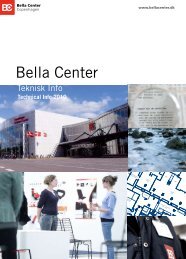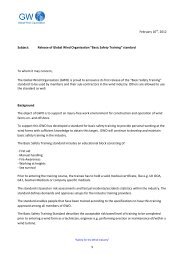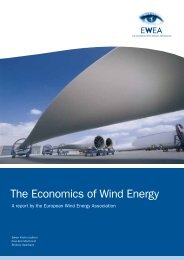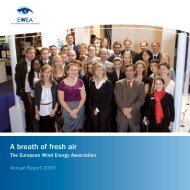Offshore Electricity Infrastructure in Europe - European Wind Energy ...
Offshore Electricity Infrastructure in Europe - European Wind Energy ...
Offshore Electricity Infrastructure in Europe - European Wind Energy ...
You also want an ePaper? Increase the reach of your titles
YUMPU automatically turns print PDFs into web optimized ePapers that Google loves.
produced. The offshore w<strong>in</strong>d farms considered <strong>in</strong><br />
<strong>Offshore</strong>Grid produce about 530 TWh annually<br />
which is almost the annual consumption of<br />
Germany. Over 25 years, this amounts to 13,300<br />
TWh. Assum<strong>in</strong>g today’s average spot market price<br />
of €50/MW, the value of this electricity is €421<br />
bn. In this relation the <strong>in</strong>frastructure costs only represent<br />
about a fifth of the electricity value that is<br />
generated offshore.<br />
• Meshed grid designs with three- and four-leg nodes<br />
can result <strong>in</strong> high net benefits and large benefit-to-<br />
CAPEX ratios, as proven by the mesh configuration<br />
<strong>in</strong> both the Direct and the Split Design. In both designs,<br />
the mesh serves primarily as a North-South<br />
<strong>in</strong>terconnection, which supports the conclusions<br />
that the North-South w<strong>in</strong>d generation correlation<br />
was the lowest (see Section 4.1). Moreover, this<br />
also confirms the need for connection to the flexible<br />
and cheap Norwegian and Swedish hydro power<br />
resources.<br />
• An offshore grid will be built step by step. Every<br />
new generation unit, <strong>in</strong>terconnection cable, political<br />
decision or economical parameter has a serious<br />
impact on both the future and the exist<strong>in</strong>g projects,<br />
and thus <strong>in</strong>fluences the design of a future offshore<br />
grid. However, the two designs presented <strong>in</strong> this<br />
report br<strong>in</strong>g useful understand<strong>in</strong>g and conclusions<br />
that allow the grid development to be brought forward<br />
with modular steps <strong>in</strong> the best possible way.<br />
Recommendations on overall grid design<br />
• Any <strong>in</strong>terconnector has a negative impact on the<br />
<strong>in</strong>terconnectors that already exists because they<br />
reduce price differences between the countries.<br />
The bus<strong>in</strong>ess case for any new <strong>in</strong>terconnector<br />
should therefore be very strong to withstand the<br />
negative impact of future <strong>in</strong>frastructure measures.<br />
Split w<strong>in</strong>d farm connections are less dependent<br />
on the trade than a direct <strong>in</strong>terconnector, and can<br />
therefore still be beneficial even with lower price<br />
differences.<br />
• Follow<strong>in</strong>g the same reason<strong>in</strong>g, the policy for<br />
merchant <strong>in</strong>terconnectors which receive exemption<br />
from EU-regulation can be questioned. The<br />
<strong>Offshore</strong>Grid – F<strong>in</strong>al Report<br />
merchant <strong>in</strong>terconnector concept can <strong>in</strong>centivise<br />
<strong>in</strong>vestments that bear large risks. However, <strong>in</strong>vestors<br />
<strong>in</strong> and owners of merchant <strong>in</strong>terconnectors<br />
are encouraged to obstruct any new <strong>in</strong>terconnector,<br />
as this will reduce their return on <strong>in</strong>vestment.<br />
It is therefore absolutely necessary that there are<br />
no conflicts of <strong>in</strong>terest, for <strong>in</strong>stance with private <strong>in</strong>vestors<br />
that have key roles <strong>in</strong> grid plann<strong>in</strong>g, grid<br />
operation or political decisions process for these<br />
issues. Otherwise the endeavour to have a s<strong>in</strong>gle<br />
EU market for electricity is put at risk.<br />
• In addition to the techno-economic advantages, the<br />
Split Design has environmental benefits because it<br />
reduces the total circuit length. Moreover, it improves<br />
the redundancy of the w<strong>in</strong>d farm connection, which<br />
improves system security and reduces the system<br />
operation risks, the need for reserve capacity, and<br />
the loss of <strong>in</strong>come <strong>in</strong> case of faults. When do<strong>in</strong>g<br />
detailed assessments for concrete cases, these<br />
merits should not be forgotten. These technical<br />
advantages also come along with tee-<strong>in</strong> and hubto-hub<br />
connections and of course <strong>in</strong> particular for<br />
the mesh grid design (step 3 of the two design<br />
approaches).<br />
• On the other side, tee-<strong>in</strong> solutions, hub-to-hub<br />
solutions and split w<strong>in</strong>d farm connections are<br />
confronted with the unsolved problem of potential<br />
regulatory framework and support scheme<br />
<strong>in</strong>compatibilities between <strong>Europe</strong>an countries. The<br />
reason is that renewable energy that is supported<br />
by one country can now flow directly <strong>in</strong>to another<br />
country, so that the country pay<strong>in</strong>g for it cannot<br />
“enjoy” all the benefits. For split w<strong>in</strong>d farm connections,<br />
this is even more difficult as the connection<br />
to the country <strong>in</strong> which the w<strong>in</strong>d farm is located<br />
is reduced. As these complexities add risks to<br />
the development of <strong>in</strong>tegrated and especially split<br />
connections, they should be solved at <strong>in</strong>ternational<br />
or bilateral level as soon as possible.<br />
• The ongo<strong>in</strong>g development of direct <strong>in</strong>terconnectors<br />
should not be slowed down, as this concept can<br />
already be realised today without large w<strong>in</strong>d farms<br />
far from shore. However it is advisable to anticipate<br />
tee-<strong>in</strong> connections for suitable future w<strong>in</strong>d farms.<br />
95









